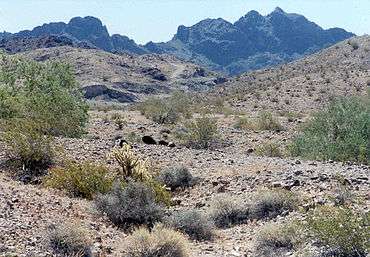Lower Colorado River Valley

| Wikimedia Commons has media related to Lower Colorado River Valley. |
The Lower Colorado River Valley ("LCRV") is the river region of the lower Colorado River of the southwestern United States in North America that rises in the Rocky Mountains and has its outlet at the Colorado River Delta in the northern Gulf of California in northwestern Mexico, between the states of Baja California and Sonora. This north–south stretch of the Colorado River forms the border between the U.S. states of California and Arizona, and Nevada and Arizona;[1] also between the Mexican states of Baja California and Sonora.
It is commonly defined as the region from below Hoover Dam and Lake Mead to its outlet at the northern Gulf of California (Sea of Cortez); it includes the Colorado River proper, canyons, the valley, mountain ranges with wilderness areas, and the floodplain and associated riparian environments. It is home to recreation activities from the river, the lakes created by dams, agriculture, and the home of various cities, communities, and towns along the river, or associated with the valley region. Five Indian reservations are located in the LCRV: the Chemehuevi, Fort Mojave and Colorado River Indian Reservations; at Yuma are the Quechan and Cocopah reservations.
The LCRV, a desert region

Some of the highest absolute air temperatures (of North America) are recorded in the LCRV, rivaling Death Valley; specifically Bullhead City, Lake Havasu City, Laughlin, Needles, Yuma, or the southeastern deserts of California, west of the Colorado River where extreme heat is the main summertime weather feature. Worldwide, only some deserts found in Africa and in the Middle East stand up with an even hotter summer climate on average. The LCRV is defined by three deserts. The Mojave Desert is in southeast California, southern Nevada, and northwest Arizona. To the south is the Sonoran Desert on both sides of the Colorado River. However an ecozone delineation occurs in the transition from Arizona to southeast California; consequently the western side of the Colorado River is defined as the western Sonoran Desert and given the name Colorado Desert; the ecozone of this western Sonoran Desert extends south into the northwest region of Sonora, Mexico and the extreme northeast of northern Baja California, Mexico.

The Lower Colorado River Valley is located in the north, and northwestern Sonoran Desert; the Sonoran Desert region proper extends from areas west of the river, and then southeastwards to southeast Arizona, south to the tip of Baja California Sur, eastwards of the Baja Peninsula cordillera, and south through Sonora state, Mexico to the northern border of neighboring Sinaloa.
The LCRV extends about 350 miles (563 km) from Hoover Dam to the Colorado River Delta. The Sonoran Desert itself is more than twice as extensive north-to-south, and about 450 miles (724 km) in width. Two species, Desert Ironwood-(Olneya tesota)[2] and the Lesser Long-nosed Bat, have geographic ranges identical to the Sonoran Desert, and are indicator species of the Sonoran Desert region. The spring flowering of Ironwood, and the bat species migration arrivals also become indicators of annual or multi-year climate trends for regions of the Sonoran Desert.
Ecological threats
The Lower Colorado River Valley subregion of the Sonoran Desert bioregion has multiple threats. Some major threats include urbanization, clearing of land for agriculture, human occupancy – especially as a result of imported external resources, and camping and camptrailers on BLM land. Other threats include harvesting for fuelwood, campfires, etc. of desert ironwood, Olneya tesota, destruction of land by offroad vehicles, especially in sand dunes, and harvesting and manipulation of groundwater.[3]
List of major cities and communities
- Laughlin, Nevada in Clark County, Nevada
- Needles, California in San Bernardino County
- Bullhead City, Arizona
- Mojave Valley, Arizona
- Lake Havasu City, Arizona
- Vidal, California
- Parker, Arizona
- Blythe, California
- Quartzite, Arizona
- Winterhaven, California in Imperial County, California
- Yuma, Arizona in Yuma County, Arizona
- San Luis, Arizona
- San Luis Río Colorado, Sonora
Complete list of towns, areas, etc, north to south
|
|
Feeder-valleys, or included small valleys
|
|
See also
- Rio Grande, the eastern river valley drainage of the Southwest USA
- Category:Rio Grande
- Category:Fauna of the U.S. Rio Grande Valleys
- List of dams of the LCRV
- List of LCRV communities (birdwatching)
References
- ↑ "Lower Colorado River Valley" section, Center for Sonoran Desert Studies;
- ↑ Atlas of United States Trees, Volume 3, Minor Western Hardwoods, Map 103-Olneya tesota
- ↑ Ecological threats, Lower Colorado River Valley
- Little. Atlas of United States Trees, Volume 3, Minor Western Hardwoods, Little, Elbert L, 1976, US Government Printing Office. Library of Congress No. 79-653298. Map 103, Olneya tesota.
External links
- Journey of the Nectar Bats
- Map, and Lesser Long-nosed Bat range; Article: Signs of Spring
- "Lower Colorado River Valley" section, Center for Sonoran Desert Studies
Ecology
Water Resources, Dams
- (southern, Arizona section), Lower Colorado River basins, planning, (with Basin/Regions map)
- (northern, Arizona section), Lower Colorado River basins, (Mohave County, & NW Arizona, Upper Colorado River Planning Area Surface Water Hydrology, w/ an Area Watersheds Map); Sacramento Wash, etc.
- US Bureau of Reclamation, "Dams Along the Lower Colorado River"
